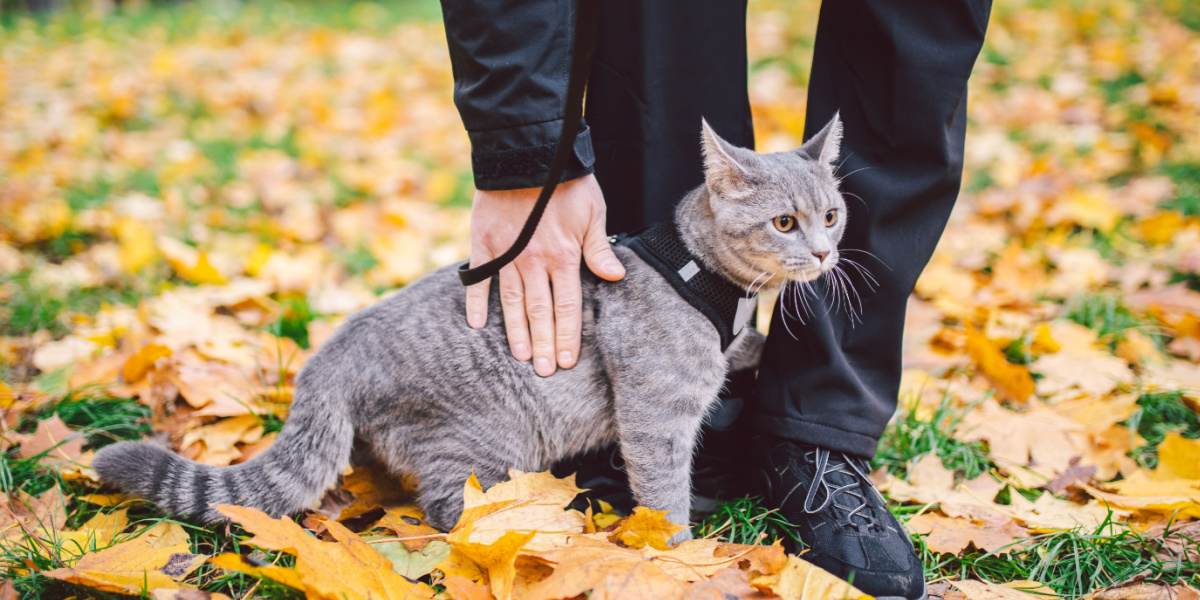
Cats make wonderful companions and bring so much joy to our lives. They’re very intelligent and retain a lot of the wildness that their ancestors had. It comes as no surprise, then, that cats be complicated creatures. Now living in households with people and other cats, cats can develop behavioral problems.
We’ll discuss the most common behavioral problems in this article. But first, let’s talk about normal cat behavior!
Normal Cat Behavior
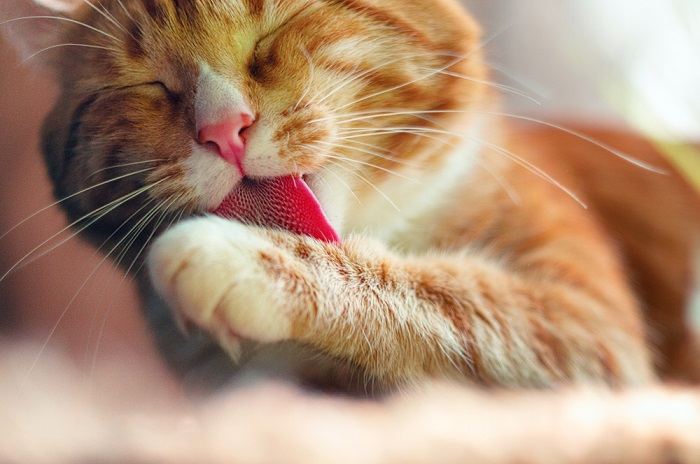
Before we talk about the most common behavioral problems in cats, let’s establish what constitutes normal cat behavior.
We’ll discuss common behavioral problems below but before we do that, we need to briefly talk about normal cat behavior. This is because many of the behaviors that we see as a problem are actually normal behaviors for cats.
It’s normal for cats to scratch, mark their territory (through urine spraying, uncovered feces, or scent marking), hunt, and show aggression toward unknown cats and in some cases fear towards humans.
Of course, even though we know this behavior can be normal, it isn’t ideal for cats to display some of these in the house. For example, urine marking on walls or scratching the furniture aren’t behaviors that we want to encourage in indoor cats.
We want to find a way to co-exist with our cats in a way that we’re both happy while also respecting normal common cat behavior. We’ll give you tips on how to do this successfully below.
Common Cat Behavioral Problems
1. Scratching Furniture
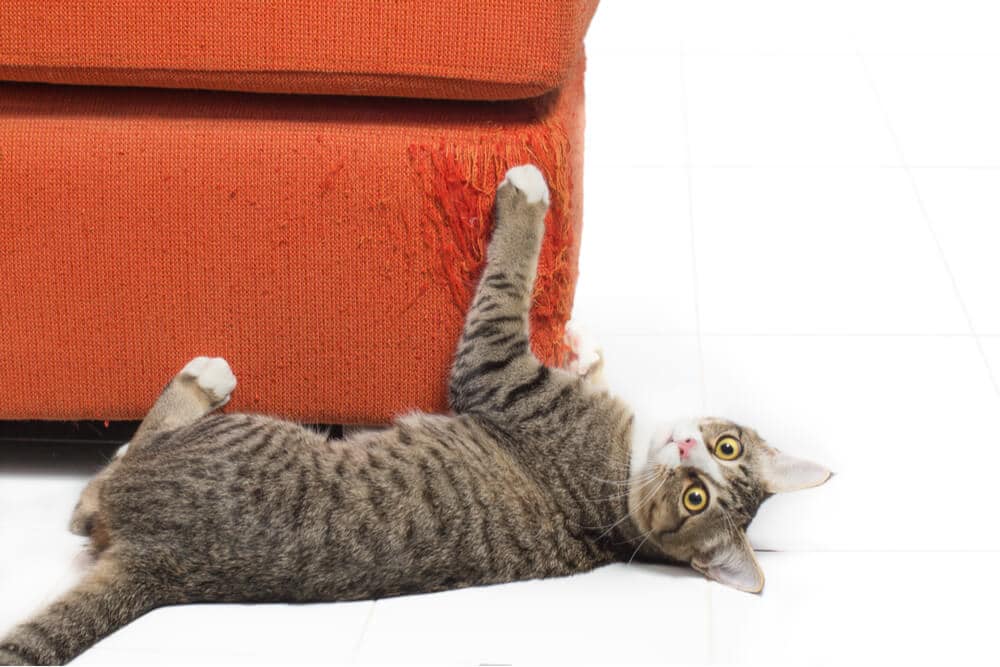
Unwanted scratching is among the most common problematic behaviors in cats.
One of the biggest problems that I hear about from owners is that their cat is scratching items in the house. This is usually curtains, sofas, chairs, and rugs. Over time, cat scratching can cause severe damage to furniture, and it can also negatively impact the human-cat bond!
However, we need to bear in mind that even though our kitty may have scratched our new favorite sofa, this is normal behavior. Cats naturally scratch to sharpen their nails and also to deposit pheromones from their paws onto items. This is a form of scent marking and can make them feel more secure in their home. Scratches also act as a visual marker to other cats that there’s another cat in the area (territory).
Even though it’s normal for cats to scratch, we’d obviously like to protect our furniture from their sharp nails. We can do this by providing other ways for our cats to scratch. Cats need scratching posts throughout the house, ideally at exits and entries.
It’s recommended to use a mixture of vertical and horizontal scratching posts and the vertical posts should be tall enough so that your cat can just about reach the top with their paws when they stretch. Anything smaller than that and they may not use it!
If you’re having issues with getting your cats to use the scratching posts, you can use a pheromone product to encourage this (Feliway). This involves making scratch markings on the post (e.g. with a screw) and then putting some of the pheromone liquid on these. Catnip sprinkled on the posts can also help to encourage usage.
Also Read: The 5 Best Cat Scratch Deterrents
2. Not Using Their Litter Box
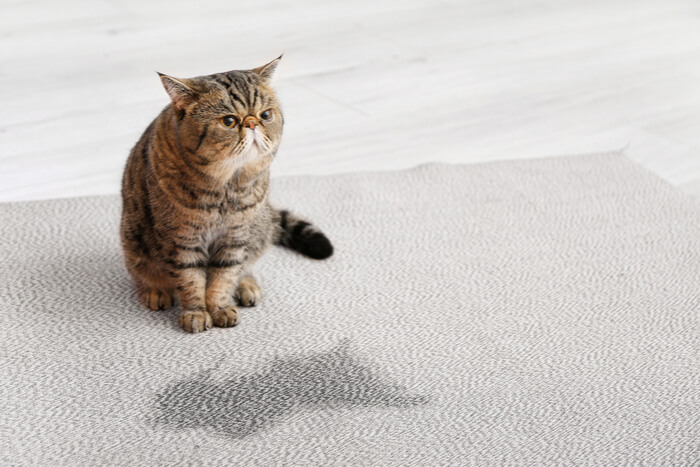
Perhaps the most dreaded of all unwanted cat behaviors, going outside of the litter box can create a lot of stress in the home.
Another big behavioral problem is cats not using their litter box, also known as inappropriate elimination. This often results in cats either peeing or pooping (or both!) around the house. Common areas that they choose to toilet include shoes, bedding, clothes, or in the shower/bath. Contrary to popular belief, they aren’t doing this to punish you. This is a sign that your cat isn’t happy with their toileting facilities.
Cats are very clean pets and the slightest thing can put them off their litter box. Common issues include:
- Litter box is too small
- Using a litter substrate that they don’t like
- Litter box in a noisy, high-traffic part of the house
- Not enough litter boxes – you need 1 per cat plus 1.
- Covered or uncovered boxes – some cats prefer uncovered.
- Litter box in a hard-to-reach area – boxes should be on each floor and easily accessible, particularly for cats with mobility issues.
If your cat is suddenly peeing or pooping around the house, there’s a reason why. You should schedule a checkup for them at your vet to make sure that there’s no underlying medical reason e.g. urinary tract infection. If there’s no medical reason to explain it, check your litter box situation and see if there’s a reason that your cat would be unhappy with it.
Also Read: The 6 Best Automatic Self Cleaning Litter Boxes
3. Urine Spraying

Most common among non-neutered cats, spraying is a territorial behavior.
Cats naturally mark their territory in the wild and they do this by urine spraying. Urine spraying is slightly different to urination, as it’s a much smaller volume of urine and it’s very concentrated. They usually do this against walls or other vertical surfaces.
It contains pheromones which act as chemical messages to other cats. It’s a method of cats marking their territory and letting other cats know that this is their turf.
Even though it’s a normal feline behavior, we obviously don’t want urine marking to occur in our homes and if our cats feel secure, they’re unlikely to urine spray. To reduce the risk of this happening, it’s important to neuter any unneutered cats as this is more common in entire cats.
Stress can trigger this behavior so if your cat has suddenly started doing this and they’re neutered, check for anything that could be causing them stress. Examples of stress include; a new baby in the house or a new cat in the neighborhood or house.
If your cat is stressed, make sure that they have enough resources. Resources include litter boxes, scratching posts, beds, hiding areas, and food and water stations. You can also plug in a synthetic pheromone diffuser (Feliway) to reduce stress and help to make your cat feel more secure.
Also Read: Best Calming Aid For Cats
4. Aggression Between Cats

Aggression between multiple cats is a very common behavioral issue.
So you’ve brought a new kitten home to your resident cat and there’s a lot of hissing and spitting. Your resident cat is acting very aggressively towards the kitten. Why is this?
As we’ve mentioned already, aggression between cats is normal in the wild. The cat’s ancestors were solitary hunters and would have lived alone. They would only interact with other cats when it was time to mate. In feral colonies, females often stay together and nurse litters together. Males often leave once they mature.
In pet cats, it’s possible for cats to live together peacefully and even be companions. There’s a higher chance of this happening if they’re neutered and have been together since they were kittens (or even better, if they are siblings)! It can be harder to introduce adult cats, but it’s possible.
If you’re introducing a new cat to a resident cat, you need to do this introduction VERY slowly. They shouldn’t be out together for at least a few weeks after a proper introduction period. During this period, we do things such as scent swapping and allowing them to see each other through a glass door/crack of a door. It’s important to not allow negative interactions to continue.
For example, if you introduce the cats through a glass door and one of the cats is trying to swipe at the other cat through the door and hiss, then stop that interaction. Separate the cats again and try again another day. If you force the interactions too soon it can create a negative relationship between the cats which can be hard to fix.
Again, don’t forget to provide plenty of resources and plug in a synthetic pheromone diffuser.
Also Read: Are Cats Possessive Of Their Owners?
5. Overgrooming
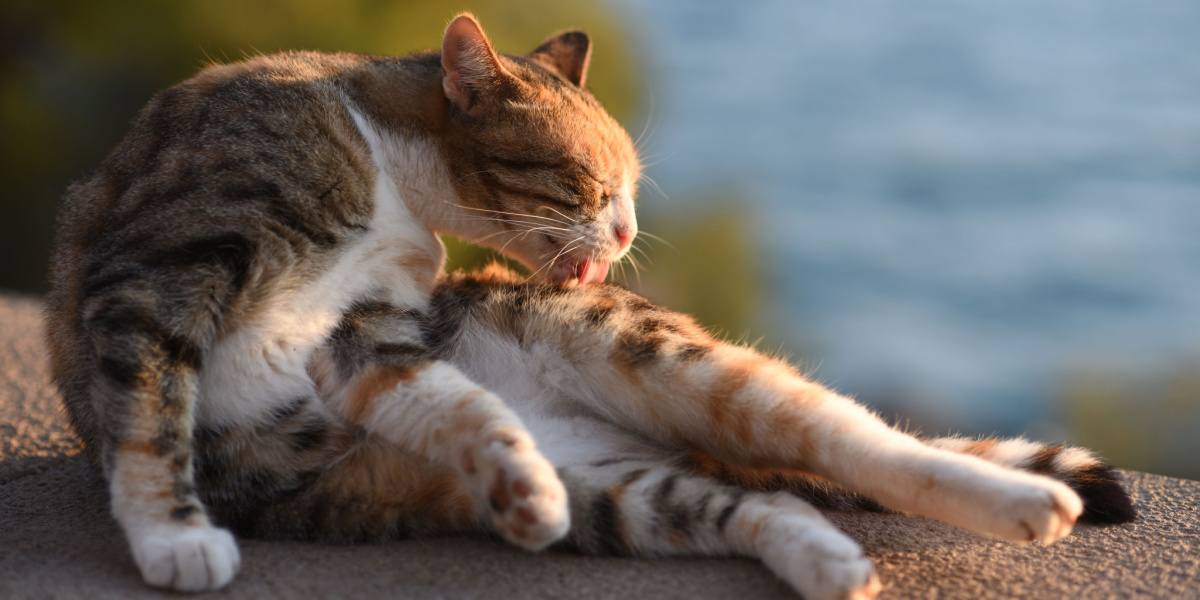
Cats spend a lot of time grooming, but excessive grooming can be a sign of underlying issues.
Overgrooming is a common behavioral issue. It’s essentially when cats spend excessive amounts of time grooming their coat and pulling out pieces of hair. Your cat will have areas of hair loss (a moth-eaten appearance), particularly on their tummies and back legs.
Overgrooming can be caused by stress, and it often has an underlying skin allergy component. Cats that are overgrooming need to see a vet to rule out other common issues of skin conditions e.g. parasites, allergies, or ringworm. Your vet may prescribe medication to help treat this if there’s an allergy contributing to the problem.
You also need to check for any causes of stress. Try to remove any potential stressors, provide plenty of resources and plug in a synthetic pheromone diffuser. I wouldn’t advise the use of buster collars aka the ‘cone of shame’ without veterinary treatment, as this isn’t addressing the underlying issue.
Also Read: Why Do Cats Lick And Clean Themselves?
6. Excessive Vocalizing
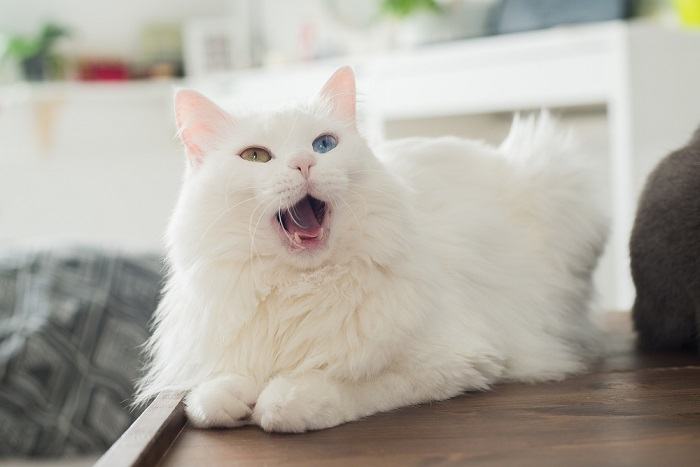
Is your cat yelling all night? Excessive meowing is another of the most common behavioral issues in cats.
Owners will often describe their cats howling/yowling during the night or excessively meowing. This may be due to the fact that cats are crepuscular creatures, meaning that they’re most active at dawn and dusk and this is often the time that they would hunt. If this is the case, they may be looking to be let outdoors if they have outdoor access.
Young unneutered cats may be vocalizing in order to find a mate. This can be resolved by neutering any unneutered cats. Older cats can be prone to conditions such as hypertension (high blood pressure) and hyperthyroidism (an overactive thyroid) which can cause excessive vocalizations. If you have an older cat that has suddenly started doing this, book them in for a veterinary checkup.
Also Read: How Do Cats Communicate With Each Other? A Veterinarian Explains
7. Night-Time Hyperactivity

Though it’s natural for cats to be active around the time you go to bed, nighttime activity can keep you up.
Similar to excessive vocalization, nighttime hyperactivity can be caused by a few things. Cats are crepuscular creatures, which means that they’ll be active during the night (particularly at dusk and dawn) so this may be why your feline friends are doing zoomies during the night.
This is normal behavior, but we appreciate it isn’t ideal when you’re trying to sleep. Providing lots of toys, particularly interactive toys, and feeders can keep your kitty occupied and entertained during the night.
Also Read: The 10 Best Cat Slow Feeders & Puzzle Feeders
8. Rough Play
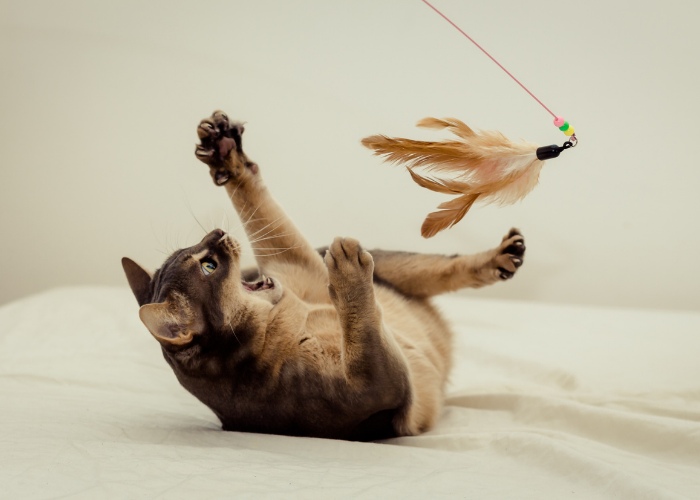
Playing with a cat is great fun and a beneficial habit, but what if the cat’s too rough?
Kitten owners often come to me for vaccinations with bitten and scratched hands. This can happen when kittens get a bit carried away with playing and confuse their owner’s hands or feet with toys. Play biting is a common issue, and although it may not hurt when they’re small, it does when they get bigger.
There are a few tips that may help with this.
- NEVER allow kittens to play with your fingers or toes.
- If your kitten attacks your hands or feet, don’t allow them to continue, and say “ouch”.
- Use toys that are attached to a rod or stick such as a fishing rod-style toy. These allow a greater distance between your hand and the toy, which helps your kitten to tell the difference.
- If your kitten is getting over-excited, and this is usually followed by biting/scratching, stop the play session at this point.
- Don’t punish your kitten or get angry at them, they don’t understand that it hurts you and they aren’t doing it on purpose.
Also Read: How To Safely Play With A Cat, According To A Cat Behaviorist
9. Aggression Towards Humans
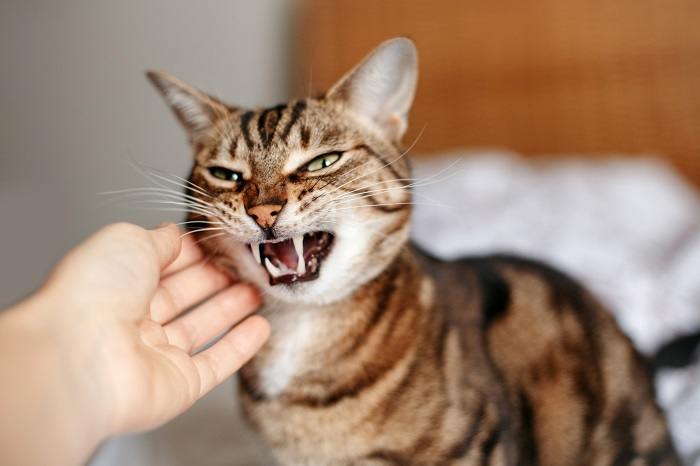
Some cats will develop an aggressive or defensive reaction to humans.
A common behavioral issue is aggression towards humans. This might be to all humans or just particular people or even just one person. Aggression can be a real problem, as cat bites can cause a nasty infection.
Aggression towards people can present in different ways. It could be due to a lack of socialization as a young kitten, which can result in a cat that is fearful and potentially aggressive towards humans. They’re defending themselves against what they perceive as a threat.
Aggression can be a cat that bites their owners during playtime. This can be a consequence of kitten play biting that was never corrected and was encouraged. It may result in a cat that bites or scratches regularly, particularly during playtime. They think this is normal play behavior.
Cats can be aggressive if they’ve had a previous negative or traumatic experience with people or even just one person. This can result in them being fearful and defensive when they’re in contact with these people.
Aggression towards people is a serious problem, particularly if there are children or immuno-compromised people in the home. Cats showing aggression should be examined by a vet to rule out health issues, and then a registered cat behaviorist should be consulted on the problem.
Also Read: How To Deal With Food Aggression In Cats
10. Fear/Anxiety

Fearfulness is another common concern among cats.
All cats are different, and just as some cats are confident and brave, others can be timid and nervous. This can be due to their personality which may be related to their parent’s personalities (genetics). Some cats are nervous or fearful due to a lack of early positive socialization with humans when they were kittens. This may result in cats that aren’t very tame and may be quite fearful around humans.
Cats may also be fearful if they’ve previously had a bad experience with people. Other cats can be anxious if they’re stressed by something in the house e.g. a new baby, new cat, new dog, and more.
If your cat has always been fearful or timid, it could be their personality but make sure that they have plenty of resources and try plugging in a synthetic pheromone diffuser to help. If it’s a new problem, look for causes of stress and get them examined by your veterinarian to rule out medical issues.
Also Read: Cat Separation Anxiety: Causes, Symptoms, And Treatment
How To Help Cat Behavioral Problems
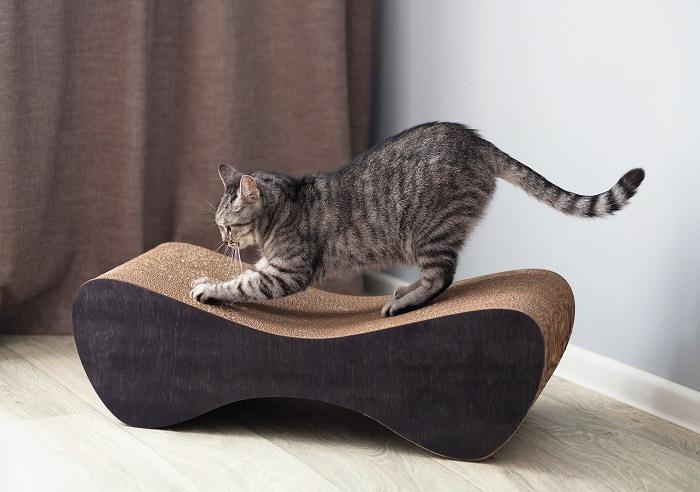
Cat behavioral problems can be resolved through environmental enrichment and other means.
Regardless of what the behavioral problem is, it means one thing; that your cat isn’t happy with something in their world. It might be litter box problems, lack of scratching posts, or something stressful in the house.
To help any behavioral issue, it’s important to first rule out a medical issue, then check for causes of stress and remove them, provide plenty of resources, and use a synthetic pheromone diffuser. These steps will go a long way to helping any behavioral issue. If the behavior isn’t resolving, consider contacting a registered cat behaviorist or veterinary behaviorist to help with the problem.
Also Read: Is Your Cat Causing Relationship Problems? What to Do When Your Cat’s in the Middle
How Not To Help Cat Behavioral Problems
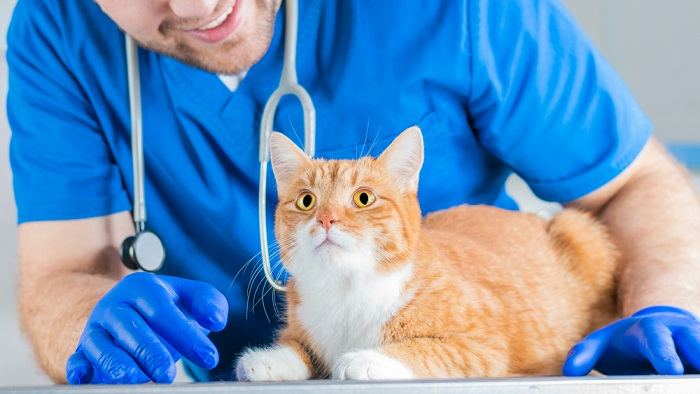
In addition to ways to help a cat with behavioral issues, there are many common responses that simply aren’t appropriate or helpful.
Cats that are showing signs of a behavioral problem need our patience and understanding. They’re telling us that there’s something wrong and it should be an alarm bell for us to take action.
However there are some things that certainly won’t help a behavioral issue and these include shouting or hitting the cat, using a water bottle, or any other punishment that involves putting unnecessary stress and suffering on your cat.
Don’t ignore cat behavioral issues; there could be an easy solution to help the situation. Seek help from your veterinarian (DVM) or a registered cat behaviorist.
Also Read: How Do I Get My Cat To Stop Doing Something?
Conclusion
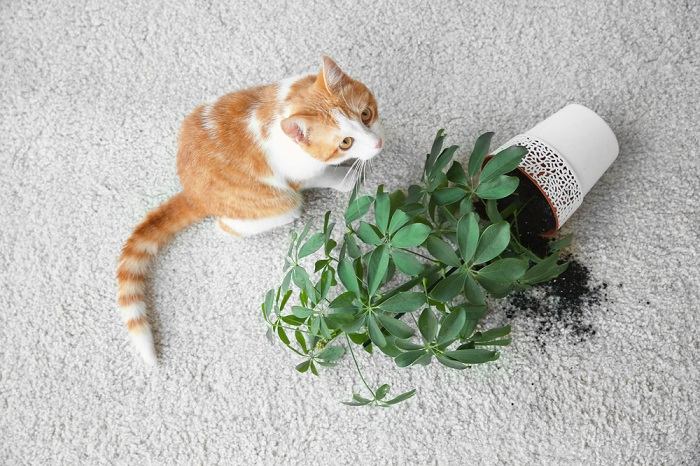
Fortunately, almost all behavioral issues can be resolved with time, patience, and understanding of feline needs.
Behavioral problems are common in cats and unfortunately a reason why many cats get re-homed. If you notice an issue such as scratching, inappropriate elimination, or urine marking with your cat, it’s best to take action straight away.
Providing plenty of resources, eliminating causes of stress, and plugging in synthetic pheromones can help with any behavioral problems. A veterinary exam can rule out an underlying medical issue that can cause some behavioral issues.
Also Read: Why Do Cats Knock Things Over?
Frequently Asked Questions
What is the most common behavior problem in cats?
Common behavior problems include scratching furniture, not using their litter box and aggression towards humans.
What are abnormal Behaviours in cats?
Abnormal behaviors include not using their litter box and doing anything that they normally don’t do. Signs of stress include hiding away, not seeking attention from their owners and overgrooming their coat.
Why is my cat having behavioral issues?
Behavioral issues can be caused by stress or issues with their litter box. Some behavioral issues can have an underlying medical cause.
How do you correct bad behavior in a cat?
Never punish your cat for abnormal behavior. Provide plenty of resources (litter boxes, scratching posts, beds, hiding areas and food and water areas) and plug in a synthetic pheromone diffuser. Visit your veterinarian to rule out an underlying medical issue.


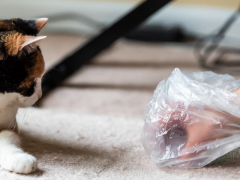



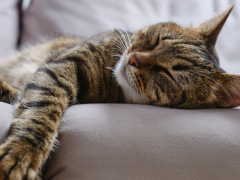

My 11 year old cat can sometimes jump at me while playing and I always wonder why she does it. She seems to overexcited.
Wow! I love this, such wonderful information